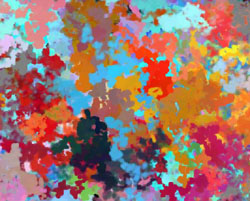Hold Still

Particles floating in a fluid jiggle constantly, an effect called Brownian motion, which makes them tricky to handle. A new trapping technique, described in the 25 March PRL, effectively cancels out the Brownian motion of a particle by continually nudging it with just the right fluid flow. The system could allow researchers to hold and manipulate smaller particles than they can with current techniques and could help them fabricate nanomachines or hold biomolecules in place while their interactions are monitored.
Even in a completely still liquid, microscopic objects jitter randomly as they are bombarded by the liquid’s molecules. Current trapping tools–such as optical tweezers, which grip with laser light–can be programmed to quickly adjust their forces and counteract Brownian agitation. But these techniques become less practical for handling objects less than 100 nanometers wide.
Graduate student Adam Cohen of Stanford University in California has used his new tool to trap fluorescent plastic beads as small as 20 nanometers across. The trapping takes place in a flat, water-filled, 20-micron-wide square chamber that is fed by four channels, one at each corner. Each channel leads to an electrode, and by adjusting the electrode voltages the system can generate an electric field pointing in any direction along the plane of the cell. The field creates a small drift in the water through an effect called electroosmosis: Extra hydrogen ions donated by the glass pile up near the top and bottom surfaces, and in a thin cell these ions can drag all of the water with them as they are pulled by the electric field.
Cohen’s computerized feedback system instantly reacts to the floating bead’s jerks, which it detects with a microscope. The system adjusts the electric field fast enough to counteract Brownian motion and keep the bead in place to within a half-micron, as if a tiny spring tethered it to an invisible post. Cohen can also program the feedback to produce a flow velocity that depends on the bead’s position according to any equation he chooses. This flexibility allows him to simulate different force laws for the bead’s motion, which he says could be applied to building nanoscale structures. “You could grab one molecule at a time and bring them to react with each other,” he says. Cohen has also used his tool to double check some predictions of Brownian motion theory.
In another mode, Cohen can drag a particle around at will by moving a cursor on a screen. In addition to beads, Cohen has trapped viruses, lipid vesicles, and segments of DNA. He says the new trap could be coupled with other probing devices, allowing researchers to watch biochemical processes as they unfold.
The trap is a major improvement of Cohen’s recent prototype [1]. He believes that with further improvements it could handle particles as small as 1 nanometer across, which is difficult to do with optical tweezers. On the other hand, optical tweezers can be rigged to trap up to several hundred objects simultaneously, something which seems very hard to do with the new technique, says David Grier of New York University. Still, “it’s a very nice piece of work,” says Grier. He and Vincent Croquette of the École Normale Supérieure in Paris both believe the new trapping system will be a useful addition to the biophysicist’s toolbox.
–Davide Castelvecchi
Davide Castelvecchi is a freelance science writer in Rome.
References
- Adam E. Cohen and W. E. Moerner, “Method for trapping and manipulating nanoscale objects in solution,” Appl. Phys. Lett. 86, 093109 (2005)


